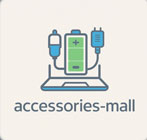1. How to Identify Your MacBook Model for Compatibility
Method 1: Use "About This Mac" (Recommended, no disassembly required)
1. Click the Apple menu in the top-left corner > "About This Mac".
2. Here, you will find the "Model Name" (e.g., MacBook Pro 13-inch, 2019) and the "Model Identifier" (e.g., A2159). The "Model Identifier" is the most accurate reference for confirming battery compatibility.
Method 2: Check the Original Battery Part Number (Final Verification)
· If you can still inspect the original battery, the Apple Part Number printed on its label (e.g., AXXXX) is the gold standard for confirming compatibility.
· Note: Removing the battery from modern MacBooks is extremely difficult and may damage the device. This is recommended for professionals only.
2. Correct Steps for First-Time Use (Based on Modern Li-ion Technology)
1. Safety First During Installation:Ensure the MacBook is completely powered off and all power sources are disconnected before installing the new battery.
2. Initial Charging:Myth Correction: No need for prolonged charging. Modern Apple batteries have built-in intelligent management chips that stop charging when full.Correct Practice: After installation, connect the power adapter and charge it fully to 100% in one go. This helps the system's power meter perform an initial calibration.
3. Battery Calibration (Optional, if the display is inaccurate):After a full charge, use the computer normally. Occasionally, let it discharge from 100% until it automatically goes to sleep (the system reserves a critical charge to prevent over-discharge), and then charge it fully again in one session. This is sufficient to optimize the accuracy of the power display.No need for multiple cycles, and avoid intentionally discharging to a specific percentage. Frequent deep discharging should be avoided.
3. What to Do If the Battery Is Not Recognized?
1. Reset the SMC (System Management Controller):This is the primary solution for resolving power, battery, and fan management issues on MacBooks. Please refer to Apple's official support website for specific SMC reset instructions based on your MacBook model (Apple Silicon or Intel).
2. Check the Connection:If you replaced the battery yourself, ensure the battery cable is fully inserted and securely locked into the motherboard's connector. A loose connection is a common cause.
3. Update macOS:Go to "System Settings" > "Software Update". The latest macOS updates often include improvements for hardware compatibility.
4. After-Sales Service Policy
· If the "Item doesn't work":Please first contact us via email with a detailed description of the issue. We will arrange a free replacement or refund for you.
· If the "Item is not received":Please first contact us via email. A very small number of packages may be delayed due to weather or other uncontrollable factors.(If the package is confirmed lost, we will issue a refund or reship a new unit).
5. Professional Tips
· The Power Display Needs Relearning:After replacing the battery, macOS may require a few complete charge cycles to recalibrate the power display. Initial inaccuracies are normal.
· Optimize Long-Term Battery Health:For users who primarily use their MacBook plugged in, it is recommended to enable "Optimized Battery Charging" (in "System Settings" > "Battery" > "Battery Health"). This feature learns your usage patterns and delays charging past 80% to slow battery aging.
· Temperature is Key:Avoiding high temperatures is the most critical factor in extending battery life. Do not use or store your MacBook in direct sunlight or hot environments.
Disclaimer: This guide is based on general lithium-ion battery knowledge. Always refer to Apple's official support documentation for specific operations. For procedures involving disassembly, it is highly recommended to have them performed by an Apple Authorized Service Provider to avoid damaging the device and voiding its warranty.










